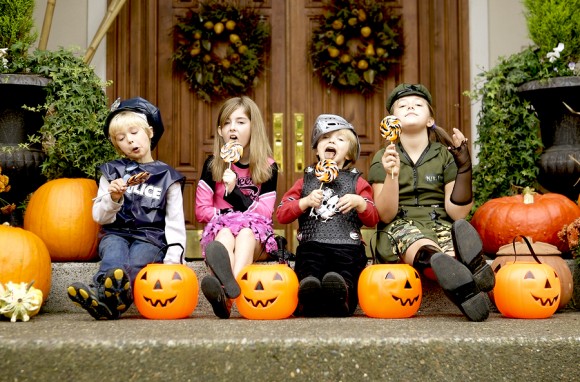I have a second, unpaid job. It’s seasonal. Each year during the last two weeks of October, I field a lot of calls from reporters. You see, I’m the world’s leading authority on poisoned Halloween candy. I acquired this distinction by default; I’m the only one who’s given the phenomenon much attention.
I became skeptical about Halloween sadism while I was a grad student. I couldn’t understand what would lead someone to hand out poisoned Halloween candy. When I’d say this to my friends, they’d be outraged: “Of course people do that! That’s just what people like that do!”
Eventually, I decided to test this. I figured that a child killed by a poisoned treat would be a big news story, so I looked at 25 years of Halloween coverage in The New York Times, the Los Angeles Times and the Chicago Tribune—the most prominent papers in the nation’s three biggest urban areas. I could not find a single report of a child who had been killed or seriously injured by a contaminated treat picked up on the course of trick-or-treating.

To be sure, one boy had died after his father gave him poisoned candy. Presumably, his father figured that so many kids were poisoned by Halloween maniacs that the death wouldn’t arouse suspicion. He was wrong on both counts and was arrested, convicted and eventually executed. The story of that poisoning—in Texas, a long way from New York, L.A. or Chicago—made all three papers, and reports of a couple other deaths were followed by retractions. One little boy had gotten into his uncle’s heroin stash and so on. That the press hadn’t covered any cases seemed telling.
I published my results in 1985 in a sociology journal and wrote a shorter piece for Psychology Today. That was a fairly popular magazine in those days, and they arranged for me to appear on NBC’s “Today Show.” I also gave dozens of newspaper and radio interviews that year. That was the beginning….
Every October since 1985, I’ve continued to get calls from reporters. Usually, it’s a young person working for a newspaper who’s been assigned to write a piece about Halloween safety. There’s a pretty good chance that a reporter who goes online to review last year’s stories about the topic will see me quoted, so I get called and re-interviewed.
Each year, I update my research and post the new version on the UD library’s UDSpace [UD’s institutional repository], but my conclusions haven’t changed. Over the years, my findings have been reported in fairly visible media, including USA Today, Reader’s Digest, Bill O’Reilly’s show on Fox News, and NPR’s “All Things Considered”—as well as hundreds of newspapers with circulations large and small. My findings also have been posted on all manner of websites, although those folks rarely bother interviewing me.
Of course, it is fun to have people interested in my research. Yet the fact that I have been giving essentially the same interview for more than 25 years makes me wonder about the value of news coverage for social scientific research. My data now cover more than 50 years, and I still haven’t found a documented case of a child who was seriously harmed by a contaminated treat. I can’t say it has never happened; after all, logicians tell us that it is impossible to prove a negative. But I can say with great confidence that it isn’t common. Nonetheless, people still worry: a 2011 poll of parents with young children found that 24 percent had concerns about poisoned treats.
So, each year I expect to get more calls. Nor would it surprise me to learn that people have devised new programs to thwart those Halloween sadists. Since I started this research, many hospitals started to x-ray children’s treats, and shopping malls began encouraging parents to bring their kids to the mall to trick-or-treat from store to store (presumably that additional foot traffic leads to more sales). Some church congregations have trunk-or-treat programs; members drive to the church parking lot, open trunks decorated for Halloween, and pass out treats to the youngsters who walk from car to car. Parents like these programs; after all, none of the children who visit the hospital, the mall or the church parking lot is poisoned, and parents can feel reassured that they’ve protected their kids.
The Halloween sadist resembles that hook-handed homicidal maniac who terrorizes Lover’s Lane; they are both central figures in urban legends. Halloween used to be about ghosts and goblins, but most of us no longer believe in supernatural terrors. What we believe in—what scares us—is criminals, and our scary stories have evolved to keep up with our fears.
So, what has this taught me? Humility. I’ve come to realize that, regardless of how much attention my research receives, some people won’t be convinced. An urban legend is harder to kill than a vampire.
Joel Best is professor of sociology and criminal justice at the University of Delaware. This article was originally published in University of Delaware Research magazine.
Was this article valuable?
Here are more articles you may enjoy.



 Viewpoint: Agentic AI Is Coming to Insurance Industry – Much Faster Than You Think
Viewpoint: Agentic AI Is Coming to Insurance Industry – Much Faster Than You Think  Hartford: 10-Year Analysis Shows Shifts in Common, Expensive Small-Business Claims
Hartford: 10-Year Analysis Shows Shifts in Common, Expensive Small-Business Claims  Truckers Who Fail English Tests Are Pulled Off Roads in Crackdown
Truckers Who Fail English Tests Are Pulled Off Roads in Crackdown  Owner of Historic Minnesota Resort Charged With Arson, Insurance Fraud
Owner of Historic Minnesota Resort Charged With Arson, Insurance Fraud 

